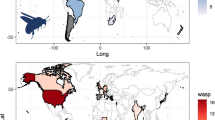Abstract
Various hypotheses have been proposed in order to explain self-anointing in hedgehogs, but until now its function is still poorly understood. In order to obtain a better understanding of self-anointing, we investigated whether this behaviour is gender, age and seasonal dependent in seven European hedgehogErinaceus europaeus Linnaeus, 1758 populations. Signs of self-anointing were observed in more than 11% of all observations. First-year independent young were found to self-anoint more than adults, while male hedgehogs bore more signs of self-anointing than females. Self-anointing in adults displayed a peak in summertime, while no clear pattern was observed for young. We conclude that self-anointing is clearly dependent on gender, age and season.
Similar content being viewed by others
References
Baker M. 1996. Fur rubbing: use of medicinal plants by capuchin monkeys (Cebus capucinus). American Journal of Primatology 38: 63–70.
Brockie R. 1976. Self-anointing by wild hedgehogs,Erinaceus europaeus, in New-Zealand. Animal Behaviour 24: 68–71.
Brodie E. D. Jr 1977. Hedgehogs use toad venom in their own defence. Nature 268: 627–628.
Burton M. 1957. Hedgehog self-anointing. Proceedings of the Zoological Society (London) 129: 452–453.
Burton M. 1969. The hedgehog. André Deutsch, London: 1–111.
Chisholm A. H. 1944. The problem of “anting”. Ibis 86: 389–405.
Craig A. J. F. K. 1999. Anting in Afrotropical birds: a review. Ostrich 70: 203–207.
D'Havé H. 2002. [Hedgehogs and pollution: vulnerable in spite of spiny coat?]. Mens en vogel 3: 170–178. [In Dutch]
Dimelow E. J. 1963. The behaviour of the hedgehog (E. erinaceus) in the routine of life in captivity. Proceedings of the Zoological Society (London) 141: 281–289.
Eibl-Eibesfeldt I. 1965. Das Duftmarkieren des Igeltanreks (Echinops telfairi Martin). Zeitschrift für Tierpsychologie 22: 810–812.
Ferkin M. H., Sorokin E. S. and Johnston R. E. 1996. Self-grooming as a sexually dimorphic communicative behaviour in meadow voles,Microtus pennsylvanicus. Animal Behaviour 51: 801–810.
Hauser D. C. 1964. Anting by grey squirrels. Journal of Mammalogy 45: 136–138.
Herter K. 1965. Hedgehogs. Phoenix House, London: 1–69.
Kenward M. G. and Roger J. H. 1997. Small sample inference for fixed effects from restricted maximum likelihood. Biometrics 53: 983–997.
Kobayashi T. M. and Watanabi M. 1981. Snake-scent application behaviour in the Siberian chipmunkEutomias sibiricus asiaticus. Proceedings of the Japan Academy 57B: 141–145.
Kristiansson H. 1984. Ecology of a hedgehogErinaceus europaeus population in southern Sweden. PhD thesis, University of Lund, Lund: 1–75.
Lindemann W. 1951. Zur Psychologie des Igels. Zeitschrift für Tierspsychologie 8: 224–251.
Litell R. C., Milliken G. A., Stroup W. W. and Wolfinger R. D. 1996. SAS system for mixed models. SAS institute Inc., Cary, North Carolina: 1–656.
Moore C. L. 1986. A hormonal basis for sex differences in the self-grooming of rats. Hormonal Behaviour 20: 155–165.
Morris P. A. 1969. Some aspects of the ecology of the hedgehog (Erinaceus europaeus). PhD thesis, University of London, London: 1–260.
Poduschka W. and Firbas W. 1969. Das Selbstbespeicheln des Igels,Erinaceus europaeus Linné, 1758, steht in Beziehung des Jacobsonschen Organes. Zeitschrift für Säugetierkunde 33: 160–172.
Reeve N. 1981. A field study of the hedgehog (Erinaceus europaeus) with particular reference to movements and behaviour. PhD thesis, University of London, Royal Holloway College, London: 1–260.
Reeve N. 1994. Hedgehogs. Poyser Natural History, London: 1–313.
Sas Institute 1999. SAS/STATuser's Guide, Version 8. SAS institute Inc., Cary, North Carolina: 1–3884.
Spruijt B. M., Van Hooff J. A. R. A. M. and Gispen W. H. 1992. Ethology and neurobiology of grooming behaviour. Physiological Reviews 72: 825–852.
Verbeke G. and Molenberghs G. 1997. Linear mixed models. A SAS-oriented approach. Springer--Verlag, New York: 1–306.
Weldon P. J. 2004. Defensive anointing: extended phenotype and unorthodox ecology. Chemoecology 14: 1–4.
Xu Z., Stoddart M., Ding H. and Zhang J. 1995. Self-anointing behaviour in the rice-field rat (Rattus rattoides). Journal of Mammalogy 76: 1238–1241.
Zito M., Evans S. and Weldon P. J. 2003. Owl monkeys (Aotus spp.) self-anoint with plants and millipedes. Folia Primatologica. 74: 159–161.
Author information
Authors and Affiliations
Additional information
Associate Editor was Andrzej Zalewski.
Rights and permissions
About this article
Cite this article
D'Havé, H., Scheirs, J., Verhagen, R. et al. Gender, age and seasonal dependent self-anointing in the European hedgehogErinaceus europaeus . Acta Theriol 50, 167–173 (2005). https://doi.org/10.1007/BF03194480
Received:
Accepted:
Issue Date:
DOI: https://doi.org/10.1007/BF03194480




